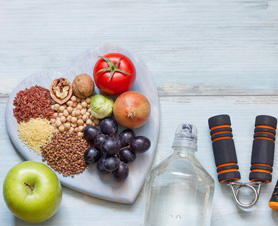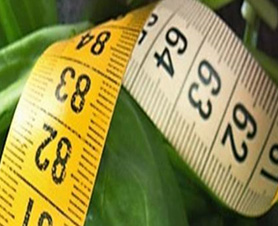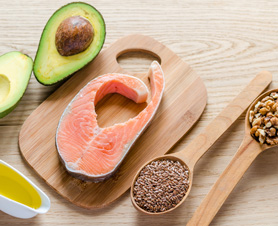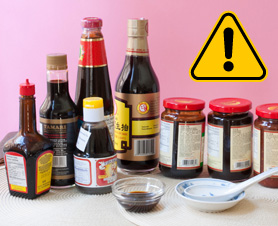Now that you are near completing or have completed cancer treatments, you may be thinking about what you can do to make healthy lifestyle changes. During treatment, you may have lost weight because of treatment-side effects (e.g., nausea), or gained weight because of:
- Medications related to your chemotherapy.
- Reduced your physical activity because of the side-effects of treatment (e.g., fatigue).
- Craved certain comfort foods (e.g., sweets or carbohydrate-laden foods) when you were feeling stressed.

Making healthy dietary changes is a common coping strategy to help women regaining a sense of control, reduce the fear of cancer coming back, improve coping and move on with everyday living. You can also lower the risk of other health problems such as obesity, heart disease, and diabetes.
Research shows some evidence of links between better survival after breast cancer and these behaviours:
- Maintain a healthy body weight
- Be physically active
- Eat more vegetables and fruits
- Eat foods containing soy and fibre
- Reduce fat, in particular, saturated fat

Photographer: Connie Cheung, RD
Courtesy of: South Riverdale Community Health Centre
Women with estrogen-receptor positive breast cancer may be concerned about including foods containing soy in their diet. Research shows that it is safe to include foods containing soy as part of your daily diet. Do not take any soy-based dietary supplements because they can contain high levels of estrogens (isoflavones, which are estrogen like compounds found in plants).
If you are considering of taking any dietary supplements, herbal supplements, and vitamins, please talk to your health care provider first. These products can have interactive effects with other drugs you might already be taking, and can strengthen or change the purpose of those drugs. If all possible, aim to meet your nutritional needs through making healthy eating choices.
Healthy body weight

Achieving and maintaining a healthy body weight is important for your overall health and can help to reduce your risks for other cancers, diabetes and heart disease. A healthy body weight can be achieved by maintaining a balance between consuming enough calories from healthy foods and drinks in a day and burning sufficient amount of calories through regular physical activity. Your health care providers may use the Body Mass Index (BMI) to find out whether your weight is putting your health at risk. BMI is a tool to assess your health risk based on your height and weight. Please talk to your health care provider if you have any questions or concerns about your weight.
To calculate your BMI, click
Dietitians of Canada (look for BMI Calculator under Learn section)
Eat more vegetables and fruits

Photographer: Connie Cheung, RD
Courtesy of: South Riverdale Community Health Centre
Vegetables and fruits are high in vitamins, minerals, and phytochemicals which are important in nourishing the body. Select vegetables and fruits in variety of colours (i.e., red, green, yellow, white, purple and orange) to get a wide variety of nutrients.
Eat more whole grain foods
Foods containing fibre can help lower cholesterol, control blood sugar, promote bowel regularity and, importantly, help to control weight by making you feel full after you eat. In addition to vegetables and fruits, fibre can be found in other plant-based foods including grains, legumes, nuts and seeds. Legumes such as beans and lentils are a high-fibre, low-fat source of protein.
Examples of legumes, lentils, beans, and pulses used in Chinese cooking are: red mung beans, green mung beans, tofu (soft and hard), soy-beverage, edamame, and peas.
-
 Rice, congee and noodles are important in the Chinese diet. By switching from white starchy carbohydrates (e.g., white rice) to whole grains (e.g., brown rice) for some meals, you can increase your fibre intake.
Rice, congee and noodles are important in the Chinese diet. By switching from white starchy carbohydrates (e.g., white rice) to whole grains (e.g., brown rice) for some meals, you can increase your fibre intake.
Examples of whole grains commonly used in Chinese cuisine to increase fibre are: brown rice, black rice, millet congee, buckwheat noodles, steel cut oatmeal, whole grain bread, and whole grain cereals.
Reduce saturated fat

Fat is a source of energy and an important part of a healthy diet, but it is important that you choose the right type and amount of fat to eat. Some fats are healthier than others.
Healthy fats can be found in fatty fish such as salmon, mackerel, sardines, and trout, omega-3 enriched eggs, and in plants such as avocados, soybeans, tofu, nuts and seeds, flaxseeds and flaxseed oil, olive oil, and canola oil.
Saturated fats can be found in animal foods, such as red meat and dairy products (e.g., cheese made from whole fat milk), and eggs. Eat red and processed meats in moderation. Saturated fats can be found in Chinese BBQ meats (e.g., BBQ crispy pork, and roast duck) and processed meats (e.g., Chinese sausage and marinated red sausage).
Suggestions on how to reduce fat in your meals:
- Select lean cuts of meat, poultry and fish and prepare them with little or no added fat.
- Choose lower fat dairy products and alternatives, such as skim or 1% milk or soy milk.
- Use healthier vegetable oils for stir-frying or pan-frying stir-fries, such as canola oil or avocado oil rather than corn oils.
- Consider using the steaming method of cooking more often to lower fat intake.
Eat Less Sugar

Sugar provides “empty calories”, giving you only energy but no other nutrients. This makes it easy to consume too many calories when eating foods high in sugar.
Examples of foods high in sugar: Sugar or soft drinks, candies, cookies, pastries, and cakes.
Fruits, milk, and certain vegetables contain some natural sugar. Grains contain starch, which the body turns into sugar. It is important to consume these foods because they contribute vitamins, minerals, fibre and other nutrients to your diet. Satisfy your thirst with water. You can try flavoring the water with citrus fruits (e.g., lemon, lime, orange), cucumbers, or berries.
Use Less Salt

Photographer: Connie Cheung, RD
Courtesy of: South Riverdale Community Health Centre
People tend to eat a lot of salt, as this ingredient is added to many processed foods and snacks. High sodium intake is related to high blood pressure, which plays a role in heart disease and stroke. Sodium can be hidden in many in-store bought Asian-based cooking sauces, such as teriyaki sauce, hoisin sauce, sweet and sour sauce, oyster sauce, soya sauce, satay sauce, BBQ sauce, and garlic and onion sauces.
Suggestions on how to reduce salt in your meals:
- Eat less marinated meats from Chinese BBQ restaurants and canned soups.
- Use less dried salted fish and salted duck eggs in cooking.
- Cook using reduced-sodium products, such as sodium-reduced (light) soya sauce and reduced-sodium chicken broth. Remember that sodium-reduced (light) soya sauce still contains salt so use it in moderation.
- Try other salt alternatives to add flavour to your meals, such as fresh and dried herbs, spices, fresh lemon and lime juice, pepper and vinegar.
Drink Less Alcohol

For most people, alcohol drinking is social. Over-consumption can lead to health problems (e.g., other cancers, heart disease, liver damage). It may increase the risk for breast cancer recurrence or developing a new cancer. You may decide to continue having the occasional drink or to stop drinking completely. But if you plan to drink, limit your alcohol intake to less than one drink per day. There are many great-tasting drink options that don’t involve alcohol (e.g., non-alcoholic beers, mocktails).
One drink of alcohol is equivalent to:
- One 12 oz (360 mL) beer (5% alcohol)
- One 5 oz (150 mL) glass of wine (12% alcohol)
- One 1.5 oz (45 mL) shot of spirits (e.g., 40% alcohol - vodka, rye, rum, gin)
If you are concerned about your alcohol consumption, please talk to your health care providers who can refer you to an addiction counsellor or program for help.
Do not smoke. Tobacco and alcohol are worse when used together than either is when used on its own.
If you have any questions about healthy eating, talk to your health care provider who can refer you to a Registered Dietitian at the hospital or in the community for nutrition advice. Your health care team is there to support you through your journey to recovery.
A Sample Day Menu
Breakfast
- ¾ cup plain oatmeal – You can sprinkle in some chopped nuts or 1 teaspoon ground flax seeds. Add 1 tsp. honey if desired.
- ½ cup berries or a slice of cantaloupe
- 1 cup skim or 1% milk or soy beverage
Lunch
- 4 ounces tofu and 1½ cups vegetables, such as broccoli, carrots, mushrooms and onion. You can stir-fry in avocado, olive or canola oil. Add chopped garlic, ginger, and a little soy sauce.
- ¾ cup cooked brown rice or noodles such as buckwheat noodle
Dinner
- 1 bowl vegetable soup
- 4-6 ounces salmon, with lemon and green onion
- ¾ cup cooked brown rice
- 1 cup cooked greens such as spinach, bok choy, Chinese broccoli (Gai Lan) etc.
Snacks
- 1 medium-sized fruit – apple, orange, peach, pear, etc.
- 1 handful of nuts (unsalted, plain or dry roasted)
- ½ cup plain yogurt topped with fresh or frozen berries
Beverages
- Drink water liberally.
- Include up to 3 cups of tea of your choice.
- Limit coffee to 1 cup daily.
To learn more about healthy eating, please refer to the following resources:
References:
- Getting Back on Track, Life After Breast Cancer Treatment, Canadian Breast Cancer Foundation-Ontario/Princess Margaret Hospital, 2010.
